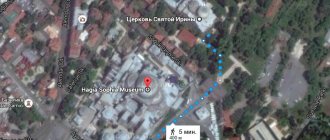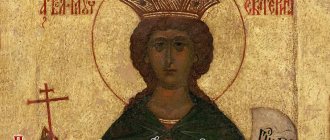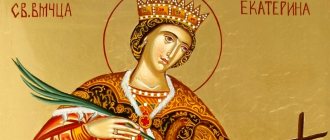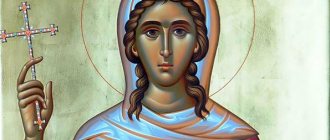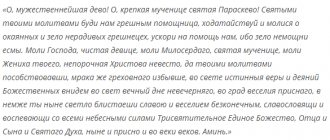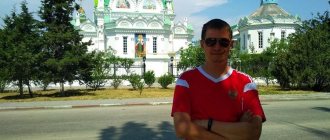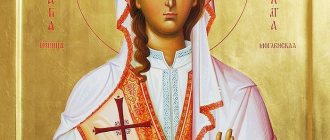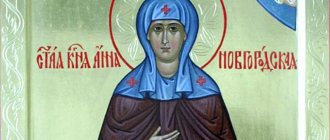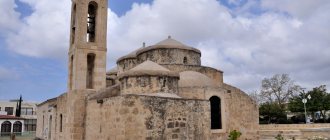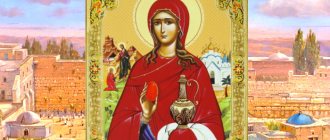Saint Irene was born at the end of the 1st century in Mygdonia. This was a time when Christians were persecuted and died painfully for their faith. The future preacher of Christianity was the daughter of the Thracian ruler of Mygdonia - Licinius. At first the girl was a pagan, like her parents. But later she converted to Christianity, for which she suffered at the beginning of the 2nd century. The Great Martyr Irene is the patroness of missionaries. Now people turn to her in prayer to strengthen faith in persecution and temptation.
Signs of Christ
Before her baptism, the Holy Great Martyr Irina bore the name that her parents gave her - Penelope. Historical reports say that the girl was distinguished by unearthly beauty. The father doted on his child. When Penelope was 6 years old, he built a luxurious country palace for her. In it, the girl lived with a teacher, whose name was Kariya, and the young women. The girl did not need anything: the ruler’s servants fulfilled her every whim. Every day a teacher, Elder Apelian, came to Penelope. He taught the girl various sciences. In addition, Apelian was a Christian (secret). He told his student about Christian virtues and the teachings of Christ.
When Penelope turned 12 years old, her father decided to marry her off. It was then that 3 birds flew into the girl’s room, with an interesting burden in their beaks. The first bird was a dove. He left an olive branch on Penelope's desk. The second bird - an eagle - gave the girl a flower wreath, and the raven left a small snake in her chambers. Penelope was very surprised when she discovered such “surprises”. But her teacher, Apelian, immediately understood the meaning of these signs. He explained that the dove represented Penelope's virtues through which she would receive God's grace in Baptism. For this, the Creator will crown her in his Kingdom with a wreath of glory. And the raven that brought Penelope the snake foreshadowed the persecution and sorrow that the girl would experience for her love for Christ.
Acceptance of Christianity
After 3 birds appeared in Penelope’s room and Apelian explained the meaning of these signs, the girl asked her father for 7 days to think. During this time she had to choose her groom. But instead of reflecting on her future family life and choosing a spouse, Penelope decided to be baptized. The Apostle Timothy and his disciple Paul performed the rite of holy Baptism. The girl converted to Christianity and changed her name. Now her name was Irina. After some time, she publicly called herself a Christian. Licinius, Penelope's father, was enraged by his daughter's behavior and ordered her to be thrown under the hooves of running wild horses. However, not a single horse harmed the girl. On the contrary, one of the horses trampled her father. However, Saint Irene loved Licinius very much, so she began to pray for him. Soon her father was resurrected. After this event, Licinius and all his nobles believed in Christ. They all accepted Baptism, becoming Christians. Licinius left his ruling post and, together with his wife, moved to his daughter’s palace to serve God.
Prayer text
People are often considered Egyptian and Macedonian martyrs. Saint, venerated in May and October, you can pray in the text and then address in your own words:
“Oh, long-suffering and glorious Irin, the all-glorious bride of Christ, the saint of God! Remain on the Throne of the Holy Trinity and enjoy indescribable bliss. Look with mercy on us bringing you this song of praise, ask mercy for us, forgiveness of sins from the Most High Lord, we, truly, we, as if we all greatly admire, ask something from Him In the same way we humbly fall to you and we ask you: gracious Lord of heaven and earth, give us your spirit of zeal to keep His holy commandments, as if we could lead the earthly field in a virtuous life, inherit the villages of paradise and there with you and with all the saints and glorify the Son and the Holy Spirit forever and ever. Amen".
The Torment of Saint Irene
After receiving Baptism, Saint Irene moved to the house of her teacher Apelian. There she prayed to the Lord day after day, read the Holy Scriptures and observed strict fasting. During the day the girl did not eat food at all, only in the evening she allowed herself some bread and water. Irina also slept little; her bed was an ordinary floor or earth. So Saint Irina spent 3 years in Mygdonia. During this time, the girl suffered due to the persecution of the changing rulers of the city. Almost every ruler tried to force Irina to worship pagan gods. But the girl was unshakable. Then Zedeki threw her into a ditch, which was filled with poisonous snakes, and left her there for 10 days. But the snakes did not bite Saint Irene, and the angel of God supported her when she was in the ditch. Seeing this, Zedekiy ordered the girl to be cut with a saw, but its edge became dull when the saw was brought to Irina. And the formidable ruler did not stop there. He ordered the girl to be tied to a mill wheel. But even then the Lord saved the life of his chosen one: no water flowed under the mill wheel. Thousands of people, seeing such miracles, renounced paganism and accepted Christianity. And when Zedeki once again expressed his indignation, the city residents stoned him. The cruel ruler was replaced by his son, Savah. He decided to avenge his father and gathered a huge army against the townspeople. But the Holy Great Martyr Irina read a prayer, and the army of Savakh, together with their ruler, became blind. After the incident, Savakh began to ask the girl for forgiveness, praying for healing. The generous Irina forgave him and restored his sight. But Savakh broke his promise and subjected the girl to further torture. This time he ordered nails to be driven into her feet, a heavy bag of sand placed on her shoulders, and in this form she was led out of town. Throughout the difficult journey, angels accompanied and supported Irina. And Savakh, to the surprise of the inhabitants of Mygdonia, suddenly died.
Brief biography
Irene of Egypt is known for her preaching activities in the 3rd century, during the reign of Emperor Aurelian. Her sister Sophia walked with her on the Egyptian soil in Christ. For preaching, girls were tortured and beheaded by order of the emperor.
Irene the Great lived in the first century after Christ. It is also called Egyptian. More is known about the life of the martyr, but his life resembles a work of art on a biblical theme.
Origin
The Macedonian saint in the world was called Penelope. Its homeland is the Mygdonia region in Macedonia. She was the daughter of the sovereign Licinius. Sometimes there are references to the fact that the Egyptian saint descended from the Slavs. The girl grew up beautiful. Her father made her sit in a high tower to protect her from temptation. His mentor was the elderly Christian Apeliano. Princess Penelope's life was busy, but not idle. The girl studied natural sciences and Christian teaching.
The emergence of birds and conversion
Once upon a time there was Penelope, who had a ghost. Three birds were sitting on the window: a dove with an olive branch, a crow with a snake and an eagle with a wreath of flowers. The girl asked the mentor what this meant. The elder explained that signs predicted his future: faith in Christ, torment for His sake and the crown of holiness.
Life and service to God
According to one legend, an angel came down to Penelope. He told her about the laws of God, Penelope was baptized by him with the name Irina, which means “peace.” According to another version, she was baptized by the Apostle Timothy, with whom Apelian was familiar. The girl went against her idolater father, dooming herself to suffering. Many pagan rulers sophisticatedly tortured the girl, forcing her to renounce Christ, but the instruments of torture did not damage her invulnerable body.
His life was devoted to missionary work. Peasants and soldiers were baptized after seeing the miracles of Irina's resurrection and patience. It is known that he preached in the cities of Magedon in Persia, Kallinikos, also known as Racca, in Mesopotamia, and Ephesus. Thanks to the efforts of the saint, even high-ranking people converted to Christianity.
The martyr entered Messembria with an olive branch in her hand, a symbol of resurrection. The entire population of the city and the ruler converted to Christianity. In Ephesus he performed miracles comparable to the miracles of the apostles. Parents whose son had died turned to the preacher. Through his prayer he woke up. The disciples walked with her as with Jesus.
The torment of the martyr
For refusing idols, King Licinius sentenced his daughter to death. He had to be trampled by wild horses. But the king himself fell under the hooves of a rebellious animal and died. Irina prayed to God, and her father was resurrected. The restored king converted to Christianity, abdicated the throne and devoted the rest of his life to prayers of repentance in the tower where his daughter lived.
The viceroy of King Zedekiah fought against Christianity. Many subjects rejected paganism. The new ruler was unable to break the culprit of the religious schism and force him to renounce the Christian God. A new execution awaited Irina - in a ditch with snakes. But God protected her. She lived for 10 days in a hole, and the snakes did not touch her. After such a miracle, even more Christians appeared in the state. Zedekiah's authority was undermined. The people rebelled against Irina's new torture and overthrew the governor.
Zedekiah's son, Zapor, sought revenge for his father. He gathered a military detachment and went on the offensive to regain his throne. But along the way, the warriors and their leader were blinded. Then Irina appeared to them and healed everyone with prayer.
Pure Sapor did not burn with gratitude. He came up with a punishment for the woman who killed her father: he hammered nails into her feet and forced her to walk 5 kilometers with a bag of sand on her shoulders. For torturing Irina, the military detachment overcame God's punishment: the ground under her feet opened up, and many soldiers died in the abyss. The survivors believed. Only Sapor remained faithful to his father’s idols.
New machinations of the enemies of Christianity overtook Irina in Raqqa. The king of Mesopotamia ordered the city prefect to arrest and torture the preacher, but the mayor was imbued with the commandments of God and converted to Christianity. Many years later, Tsar Sapor again questioned Irina. This time he managed to behead her. But his preaching mission was not completed, and an angel resurrected the martyr.
Death and canonization
The end of Saint Irene's life also echoes the events of Jerusalem. An angel brought her news of imminent death. Irina, with her students and mentor Apelyan, went to a cave in the mountains. The saint entered it alone, ordered the entrance to be closed with a stone and opened after 4 days. When the tomb was opened, it was empty.
In different sources, researchers find different dates of death. The exact time of canonization is also unknown. They began to venerate her as a holy martyr back in ancient Constantinople.
Miracles of Christ
During her stay in Mygdonia, Saint Irene preached the Christian faith and performed many miracles. With the help of prayer, she healed the sick, drove away demons and cleansed lepers. And one day the girl performed a real miracle: she resurrected a dead young man whose parents were mourning him. Later, Irina moved from Mygdonia to Calliope, and from there to Mesemvria. In every city of Thrace where Irina was, she preached Christianity. But even here it was not without torment. The city rulers were aggressive towards the teachings of Christ and his followers. They tried to burn the girl on a hot grate. But the Lord saved his chosen one from death. The biggest miracle with Saint Irene happened in the city of Mesemvria. The ruler of the city, Prince Savory, ordered the girl’s head to be cut off. And his order was carried out. And then they buried the holy martyr outside the city. But the Lord wanted Irina to continue preaching Christianity, so he resurrected her. The Almighty ordered his follower to return to Mesemvria. Residents of the city could not believe their eyes: in front of them was the deceased Irina. After what happened, Prince Savory and his people believed in the Lord God Christ and received Baptism. It was so difficult for the great martyr Irina to introduce people to the true faith.
What can you ask the Great Martyr for?
Sant'Irina helps improve your health, overcome life's challenges and save your family. She patronizes women who bear her name. They ask the saint for good luck and help overcome doubts.
Protection from troubles and troubles
Prayer to a martyr will help you find a way out of a difficult situation associated with misunderstanding of others. Just as an angel helped a saint escape unharmed from an earthly prison with snakes, so Irina will help a praying person escape unharmed. It is only important to be patient and count on the help of the patron and the Lord.
Protection from sins
Just as a father protected his daughter Penelope from the evil influence of the outside world, so Saint Irene protects those who pray to her from vices and base passions that destroy the soul.
Family happiness
Girls pray to the martyr for a happy marriage, and married women ask to preserve love, fidelity and respect in the family.
Health
Prayer to a martyr relieves mental and physical pain, strengthens the spirit in the treatment of intractable diseases.
Helps in gaining confidence
A saint with weakened faith prays to strengthen his willpower in the fight against temptations and to defend his own opinion.
Career growth
Prayers to the saint will help you avoid the machinations of competitors and scoundrels, win the favor of leaders of a higher rank and receive from them the highest assessment of your work.
Protection from diseases
On the body of the invulnerable Irina, saws and mill wheels broke, and fierce horses and fierce snakes became meek. Prayers to the saint ask for perseverance, good health, resistance to bodily injury, poisons, viruses and bacteria.
The Last Days of Saint Irene
Saint Irene of Macedon died in the city of Ephesus. The girl foresaw her death. A few days before her death, Irina, together with her teacher, Elder Apelian, went outside the city to one of the mountain caves. Having entered there, Irina ordered her companions to close the cave entrance with a heavy stone. Here she died in prayer. It happened on May 5th. On the 4th day, Christians came to the cave to take away the body of Saint Irene. But when they rolled away the stone, they saw that there was no one there. People realized that the girl’s body was taken to heaven by the Almighty. During her stay in Ephesus, the follower of Christ did not stop preaching Christianity. Thanks to her, many people believed in the Lord God and received Baptism. By the way, the girl was transported to Ephesus from Mygdonia on a cloud. Some sources say that Saint Irene preached the Gospel among the Slavic people, and was burned in Thessaloniki.
What date is Angel Irina Day?
Angel's Day and Name Day are not identical, but different dates. Angel's Day is the day of a person's baptism, and Name Day is a day dedicated to the saint after whom he was named. At first, the name Irina was only allowed to be given to girls from noble families.
Only a few centuries later, girls from ordinary families began to be called this name. This name is still widespread throughout Russia. Name day (angel day) of Irina according to the church calendar: April 29, May 18, May 26, October 1. The most famous patrons named Irina and their angel day.
Irina of Corinth - revered on April 29: of her own free will, she lived in ascetic conditions in a cave with other Christians, where she spent her days in prayer. Later she was captured by the pagans, who brutally tortured her and killed her with a sword on the day of Holy Easter.
To understand when Irina’s angel day is, it’s enough to know the date of baptism in the church
Irina of Macedonia - venerated on May 18: The first from a pagan family to convert to Christianity, then she persuaded her father to also be baptized. Irina was tortured many times, but it did not bring her the slightest harm, after which she was released. Before her death, she asked to be locked in a cave. When the cave was opened a few days later, Irina was not found there.
Irina of Cappodacia: venerated on August 10: she voluntarily took monastic vows, distributing all her property to the poor, later became abbess, died at a ripe old age after 920. During her life, she had visions that she conveyed to people, thereby saving their lives, but not everyone believed her
Irina of Egypt : - revered on October 1: in the third century in Egypt, without hiding, she professed the Christian faith. She was captured by the pagans and brutally tortured, after which she was beheaded with a sword.
Temples
In Constantinople, several beautiful churches were built in memory of the follower of Christ. In Pokrovskoye (Russia, Moscow) you can find the Church of St. Irene. The chapel of the holy martyr was added in 1635 to the parish church of St. N. the Wonderworker. In 1790-1792, a church was erected with chapels of the holy martyrs Irina and Catherine. People began to call the temple “Pokrovskaya Irina the Martyr.” In 1891, the church was rebuilt and significantly expanded. During the revolution of 1917, the church was closed and the building itself was partially destroyed. And only in 1992 the holy building was returned to the church. Now the temple is the only one in Moscow consecrated in honor of St. Irene. Now there is a busy life in it. A Sunday school has been opened at the church, where theology is taught, a library, computer classes, and a film library are created. But the Church of the Intercession of St. Irene is not famous for this, but for its beautiful incense, which is called “Irinin”. Here the priest was able to create a laboratory where he studies ancient recipes for preparing fragrant compositions. The aroma of Irina’s incense simply fascinates parishioners. A church in honor of St. Irene can also be found in Volgovo (40 km from St. Petersburg). This village is small, as is the church itself. Now in Volgovo work is underway to reconstruct and restore it. In the future, it is planned to open a museum of Orthodox culture there, for which there are plenty of exhibits and materials collected.
Temple of Saint Irene in Istanbul
But the most magnificent Church of Hagia Irene is located in Istanbul (Türkiye). However, it is dedicated not to Irene of Macedonia, but to the Great Martyrs Sophia and Irene of Egypt. This is not only the most ancient and beautiful temple in the city, but also the calling card of a large metropolis. The Byzantine church is located in the center of Istanbul - the Sultanahmet district. The church was built in the 4th century on the site of the ancient temple of Aphrodite. Initially, the holy building was considered the main church of Constantinople. In 532 the temple was burned, and in 548 it was rebuilt under the holy emperor Justinian. In 740, the Church of St. Irene was severely damaged by an earthquake. In 1453, Constantinople was conquered by the Ottomans, but they decided not to convert the temple into a mosque. From the 16th to the 18th centuries, the Byzantine church was used to store weapons, and in 1846 it was turned into an Archaeological Museum. In 1869, the temple was transformed into the Imperial Museum, and in 1908 - into a military museum. Today, the Byzantine temple serves as a concert hall due to its impressive size and excellent acoustics. In 2000, Faruk Saras, a famous Turkish couturier, organized a modeling show there, which he dedicated to the history of the Ottoman Empire. The Istanbul Church of St. Irene is unique in that it has been preserved in almost unchanged condition. Thousands of tourists come to see it, the largest percentage of whom are Christians.
What does Saint Irene help with?
Over the years of her missionary activity, the holy martyr Irene was able to convert more than 10,000 pagans to Christians. These included not only ordinary people, but also rulers of different cities. The icon of St. Irene of Macedon is found in almost every Orthodox church. People turn to her to ask for health, vitality, family well-being and confidence. The memory of the Holy Great Martyr Irina is celebrated on May 5 (the day of her death). According to the new style - May 18. In honor of the icon of St. Irene, an estate was built in Moscow, which later went to the Naryshkins. Saint Irene patronizes many. What does she help with? The Holy Great Martyr protects from various kinds of misfortunes. Prayer to Saint Irene helps strengthen family relationships. The saint also helps to gain confidence and achieve career success.
Meaning in Orthodoxy
Despite the apocryphal description of the lives of the ancient saints and the difficulty of distinguishing between their images, the modern Orthodox Church honors Irene of Macedon and Egypt as an example of firm faith in Christ and perseverance. The women humbly refused marriage for the sake of the Supreme Bridegroom. They endured the hardships of the missionary life of pilgrims and obediently went to execution. And for their selfless service to the Lord, he rewarded them with eternal glory and life in the Kingdom of God.
Irene the Great converted more than 10 thousand inhabitants of ancient Persia and Mesopotamia to Christianity. He healed, cast out demons and resurrected. According to the legends about her, parallels can be drawn between the episodes of her life and the Mother of God Jesus Christ - the announcement of the service of God, the machinations of the rulers and the admiration. For an Orthodox Christian, Irina the Great is an example of righteous life and selfless faith. He sponsors preachers, missionaries, people who are studying and preparing to accept Christianity.
Icon of Saint Irene of Egypt
The early Christian missionaries had a difficult journey. Saint Irene of Egypt, together with other followers of Christ, brought the good news to the Egyptian people. She preached the Christian faith and performed miracles. Many Egyptians in those days were baptized and believed in the true God. However, Saint Irene’s sermon did not last long. In one of the Egyptian cities she was captured along with another missionary, Saint Sophia. After numerous tortures, the girls were beheaded. Years passed, and only during the reign of Emperor Constantine the Great the relics of Saints Sophia and Irene were transported to Constantinople. Subsequently, a temple was built in Byzantium in honor of the great martyrs.
The icon of St. Irene of Egypt helps a person throughout his life. The Holy Great Martyr intercedes for people in their sorrow, thanks the Almighty for the joy sent down. Prayer to Saint Irene of Egypt protects from troubles, troubles, and helps to avoid sinful acts. The patron saint protects people from evil and disease. The holy martyr Irina prays for all Orthodox people before the Lord God. Her icon is of great value for a person. Priests recommend having it in the home of those whom it protects. The Orthodox holiday in memory of St. Irene of Egypt is celebrated on September 18 (new style - October 1).
IRINA
To Byzantium. In art, I. was depicted with a cross in her hand, wearing a royal robe and a crown, with a transparent scarf sometimes hanging down from it. In the mosaics of the narthex of the katholikon of the Hosios Loukas monastery (30-40s of the 11th century), I. is represented in an azure-colored dalmatic with a gold ornamented shoulder and precious stones along a gold border, a crown on her head, a cross in her right hand, on the left is a sphere with the Calvary cross. In richly decorated clothes, the saint is depicted full-length in Karanlik-kilis in Goreme (Cappadocia), mid-3rd quarter. XI century; in c. Prototroni on Naxos, con. XI century; in c. St. Archangels in Zemo-Krikhi (Georgia), mid-2nd half. XI century; c. St. Doctors in Kastoria, to the east. wall of the narthex, con. XII century; in c. St. Vlasia in Frilingianika on the island of Kythira, 90s. XIII century; c. Rev. Our Lady of Leviski in Prizren, in the north-west. pillar, 1310-1313; in the church of the monastery of St. George in Ubisi (Georgia), XIV century. In c. St. John Chrysostom in Geraki (Eraki), con. XIII - beginning XIV century, she is depicted in a medallion.
Great Martyrs Marina and Irina. Reverse side of the icon “Mr. George in Life". XIII century (Byzantine Museum, Athens) Great Martyrs Marina and Irina. Reverse side of the icon “Mr. George in Life". XIII century (Byzantine Museum, Athens)
The image of the saint is found in miniatures of manuscripts. I.'s height is presented in the Greek manuscript. Service Gospel (Vat. gr. 1156. Fol. 306v; under May 4), created in K-field at the end. XI century In the Codex of Gertrude (as part of the Psalter of Archbishop Egbert of Trier, Cividale del Friuli, National Archaeological Museum. Cod. CXXXVI), among the miniatures created in Kyiv in 1078-1086, there is a ktitor composition on which the apostle. Peter and I. are brought to the Savior on the throne of the Kyiv prince. Yaropolk and his wife king. Irina (L. 10 vol.). I. is dressed in a blue dress with gold trim, and has a gold crown on her head (Smirnova. 1998).
Several iconographic images of the saint were preserved in the sacristy of the monastery of the VMC. Catherine in Sinai. In a crown and a lorate dalmatic, she is represented on menaic icons: in a series of 6 icons (hexaptych) 2nd floor. XI - 1st half. XII century; on one of the 12 menaic icons (dodecaptych) con. XII - beginning XIII century (the icons are on the pillars of the basilica). On an icon of the 12th century. “Saints Nicholas, Sava, Varvara and Irina” I. is depicted full-length, wearing a crown and imp. robe - blue lorate dalmatic, with long earrings in his ears, with a cross in his hand. Above her figure is the inscription: “AGIA EIPINH.” According to R. Nelson, the icon depicts not the Great Martyr, but the Emperor. Irina (Holy Image, Hallowed Ground. 2006. P. 262-263. Cat. 54). The researcher’s main argument—the saint’s royal robes—cannot be accepted, since images of I. such iconography are well known in Byzantium. art, including on earlier menaine icons. On the right margin of the Sinai icon “The Crucifixion, with Deesis and Saints in the Margins,” made c. 1250 in the workshop of the crusaders in the monastery of the VMC. Catherine in Sinai in imitation of the image of the 12th century. (Ibid. P. 156-157. Cat. 15), - a waist image, paired with the image of the VMC. Catherine; on the lower field of the icon “St. Nicholas the Wonderworker, with scenes of life and selected saints" beginning. XV century (Ibid. P. 160-161. Cat. 17) - full-length, in a blue dalmatic with gold finial, next to Saints Helen and Marina.
VMC. Irina. Fresco of Karanlik Kilise in Goreme, Cappadocia. Ser.—3rd quarter. XI century
VMC. Irina. Fresco of Karanlik Kilise in Goreme, Cappadocia. Ser.—3rd quarter. XI century
On some icons, where the inscriptions have not been preserved, the saint in royal robes is presumably identified as I., for example. on the back of the 2-sided icon “Mr. St. George the Victorious in his life. Great Martyrs Marina and Irina" (XIII century, Byzantine Museum in Athens). In this icon, the saints stand in prayer to Jesus Christ, who blesses them with both hands. I. is depicted in a cloak with a mantle and a crown. Another supposed image of I. is on the icon of the 1st quarter. XIV century (Byzantine Museum in Verria).
In the fresco minologies of Balkan churches, the scene of I.’s martyrdom was also depicted: in c. Annunciation of the Most Holy Our Lady of Gračanica monastery (ca. 1320) and in the c. 40 Martyrs of Sebaste in Veliko Tarnovo (c. 1230).
In the post-Byzantine period. The period of Iconography generally follows the Byzantine period. traditions. Since the 15th century. her outfit is often supplemented with new details, and the type of hairstyle is slightly changed. On a small icon, 1st floor. XV century from the private collection “Vmch. St. George the Victorious, military medical center. Irina, ap. Andrew the First-Called, military commander. Paraskeva" I. is presented in a red dalmatic and a crown, her hair is gathered under a blue cap, in her hand, as usual, she holds a cross (32x23 cm; Sotheby's London, 1991, 11, 28 Icons, Russian Pictures and Works of Art, Thursday 28th November 1991. L., 1991. P. 145). In Greco-cargo. manuscript (RNB. OI 58) con. XV century I. is depicted in a medallion, on the same sheet with another St. wives and under the 5th of May in height, in royal attire - dalmatic with lor and in a golden crown (Evseeva. Athos Book. 1998. P. 221, 301). The image of I. is known on the frescoes of Cypriot churches in Louvaras, in the c. martyr Mamanta (1495) and in c. arch. Michael and Presv. The Virgin Mary (1514) in Galata - in royal robes (Stylianou. The Painted Churches. 1997. P. 95, 254). Her image has been preserved in c. St. Demetrius in Kavianika on the island of Kythira (mid-17th century).
In Kievan Rus I. was one of the most revered saints. Her name is mentioned in all the most ancient monthly books. Kng. Irina, the wife of Yaroslav the Wise, built a monastery in the name of her heavenly patroness (mentioned in the Laurentian Chronicle under 1037; PSRL. 1997. Issue 1. Stb. 151).
In the Cathedral of St. Sophia in Kyiv (40s of the 11th century), the image of I. is considered to be the image of a martyr with flowing hair, in the imp. robe and crown, to the east. slope of the central pillar in the north-west. parts of the temple, symmetrically to the image of Queen Helen. In her right hand she holds a cross, with her left she supports the edge of her robe and a scarf. Comparison of this image with the image of equal. Queen Helena, features of the iconographic program of the Cathedral of St. Sophia, in which St. stand out. patrons of the family led. book Yaroslav, as well as the iconographic features of the image confirm this assumption (Gerasimenko et al. 2009).
The image of I. was included in the iconographic program of the deacon Ts. The Transfiguration of the Savior on Nereditsa (1199) - in a medallion, in the same row as the VMC. Catherine and the martyrs Christina and Agapia (Pivovarova. 1999. P. 222).
A rare example of the image of I. in Domong applied art. era - a barm medallion from the Ryazan treasure, made using the enamel technique (late 12th - early 13th centuries, GOP). In the central medallion the Mother of God is depicted, in 2 neighboring medallions, slightly smaller in size, there are half-figures of Saints I. (inscription: “Orina”) and Barbara, both in maforia, with crosses in their hands, without crowns (Martynova MV Collier de “barmes” de Riazan // Sainte Russie. 2010. P. 208-209).
Identification of I. in Russian, as in Byzantium. art is sometimes difficult. Usually the inscription is limited to the words: “Holy Martyr Irene,” which can indicate both the Great Martyr and the Martyr Irene, glorified along with the martyrs Agapia and Chionia. One of the main features for identifying I. is her royal attire. The Sofia iconographic original gives a brief description of her appearance: “Martyr Irinia. Irina maiden royal crown, cinnabar robe” (Sofia list of the original Novgorod edition // SbODI for 1873, 1873. P. 28).
The half-length image of I., poorly preserved, reached the minology frescoes of May in c. right Simeon the God-Receiver of the Zverin Monastery in Vel. Novgorod con. 60s - early 70s XV century (Lifshits. 1987. P. 421).
Savior, with the upcoming ap. Peter, military Irina, book. Yaropolkom and king. Irina. Miniature from the Code of Gertrude. 1078–1086 (National Archaeological Museum, Cividale del Friuli. Cod. CXXXVI. Fol. 10v)
Savior, with the upcoming ap. Peter, military Irina, book. Yaropolkom and king. Irina. Miniature from the Code of Gertrude. 1078–1086 (National Archaeological Museum, Cividale del Friuli. Cod. CXXXVI. Fol. 10v)
Saints Nicholas the Wonderworker, Savva the Sanctified, Barbara and Irina. Icon. XII century (sacristy of the Monastery of Catherine the Great in Sinai)
Saints Nicholas the Wonderworker, Savva the Sanctified, Barbara and Irina. Icon. XII century (sacristy of the Monastery of Catherine the Great in Sinai)
Interest in the image of I. increased significantly in the end. XVI century, during the reign of Tsar Feodor Ioannovich, whose wife was Irina Feodorovna Godunova. Information about the date of birth of the queen has not been preserved, but it can be argued that her heavenly patroness was I. This idea is confirmed by temple construction. Thus, in the Borovsk Paphnutius Monastery in the Nativity Cathedral, 2 chapels were consecrated in honor of St. patrons of the royal couple, St. Theodore Stratilates and I. Above the north. the portal of the cathedral, next to the Irininsky chapel, fragments of a fresco with their image have been preserved. In 1600, in the Ipatievsky Kostroma monastery, a gate 2-tent temple in the name of the Great Martyr was consecrated. Theodore Stratelates and the military Irene (at the end of the 17th century it was reconsecrated in the name of St. John the Baptist and the Apostles Peter and Paul). In the Kirillov Belozersky Monastery in the c. At the Transfiguration, Tsar Theodore built a chapel in the name of the Great Church. Irina, into which the queen placed an icon and a shroud with the image of her saint. The icon of 1595 from the Irininsky chapel of the Kirillov Belozersky Monastery is one of the rare icons in ancient Russia. iconography of individual images of I. She is represented in a green dress with a mantle and an ocher maforia tied on her chest, with strands of hair escaping from under the dress lying on her shoulders; in his raised right hand I. holds a cross, in his left hand a scroll with the text of the Creed; the angels place a crown on her head, which is perceived as martyrdom, and not as a sign of noble origin; inscription: “Holy Martyr of Christ Irina” (Icons of the Kirillo-Belozersky Museum-Reserve. 2005. P. 198-199. Cat. 58). For this icon, in the workshop of Queen Irina, a shroud (GRM) was sewn with the same iconography (Russian mon-ri. 1997. P. 46), and several more were also made. sewn images I.
The iconography of a number of images of I. differs from the traditional one. So, on the embroidered icon “Vmch. Theodore Stratilates and the military Irina” from the marching iconostasis (1592, Russian Museum) Irina is depicted without a crown, with uncovered hair; the absence of a crown can be explained by restoration intervention, during which the figures of saints, due to dilapidation, were transferred to a new base (Pleshanova, Likhacheva. 1985. P. 209. Cat. 106). In the Novodevichy Monastery, Queen Irina Godunova placed an embroidered shroud “Praise of the Mother of God” (GIM), made after her tonsure with the name of the Queen of the Great Mother of God. Alexandra (Mayasova. 1976). The composition “Praise of the Mother of God” was supplemented by life-size images of St. patroness of the queen - I. and Alexandra. There is also an image of I. on the shrouds “Our Lady of Kazan, with Saints Theodore Stratelates and Irene” (GRM) and “Our Lady of the Sign”, with Saints Theodore Stratelates and Irene (GIM) (She also. 2004. pp. 40-42) .
VMC. Irina. Hanging veil. Con. XVI century (GRM)
VMC. Irina. Hanging veil. Con. XVI century (GRM)
Vmch. Theodore Stratilates and the military Irina. Sewn icon. 1592 (GRM)
Vmch. Theodore Stratilates and the military Irina. Sewn icon. 1592 (GRM)
Tsarina Irina Godunova owned a small reliquary icon “St. Martyr Irina. Our Lady on the Throne” (1589, GMMC; Sterligova I. Moscou: Le “Grand atelier”, orfevrerie et broderie d'art a la cour // Sainte Russie. 2010. P. 478).
In con. XVI century paired images of St. Theodora and I. also appear in icon painting: for example, on the icon “Mr. Theodore Stratilates and the military service. Irina” (collection of M. Yu. Abramov) I. is depicted in a dress, maforia and without a crown.
On menaion icons starting from the 16th century. I. is depicted on May 5 in royal vestments, with a crown on his head, as on the Vologda minea of the 2nd floor. XVI century (VGIAHMZ) or at least the 16th century. from the Icon Museum in Recklinghausen (Germany). This tradition was continued at a later time (for example, the Palekh icon from the collection of M. E. De Buar (Elizabeth)).
I. is depicted full-length, in a red dalmatic with a golden horn and a golden crown on her uncovered curly hair, with a cross in her hand, among St. women on the double-row icon “Selected Saints” (late 16th century) from the Entrance to Jerusalem Church. in Kargopol (VGIAHMZ) (Icons of Ancient Rus'. 1993. P. 60)
Since the 17th century on icons where saints are arranged according to ranks of holiness, I. is depicted among the great martyrs, for example. on 3-leaf folds: on the left wing there is a fold “Our Lady of Vladimir, with feasts and saints” (early 17th century, Tretyakov Gallery; Our Lady of Vladimir. 1995. P. 118); on the right wing of the folding “Our Lady of Vladimir, with feasts and saints” (1st quarter of the 17th century, Old Believer Intercession Cathedral in Rogozhskaya Sloboda); below on the left wing of the marching iconostasis (mid-17th century, Old Believer Intercession Cathedral in Rogozhskaya Sloboda; Antiquities and spiritual shrines of the Old Believers. 2005. pp. 82-84, 104-107). On these icons I. is represented in a dress with a shoulder and a border in front (a kind of dalmatic), in a cloak attached to one shoulder, and a crenate crown.
The veneration of I. in Moscow is marked by the construction of the Irininskaya Church on Vozdvizhenka by boyar V. I. Streshnev. (known from documents from 1629); after Streshnev's estate was transferred to Naryshkin. In 1874, with the assistance of the Moscow Archive of the Ministry of Foreign Affairs, which owned the land plot, the church was rebuilt in the old forms; destroyed in 1937. In this temple, an ancient local image of I. was kept in a silver frame with 14 hallmarks of his life.
VMC. Irina. Fragment of the double-row icon “Selected Saints”. Con. XVI century (VGIAHMZ)
VMC. Irina. Fragment of the double-row icon “Selected Saints”. Con. XVI century (VGIAHMZ)
VMC. Irina in life. Icon. 2nd half XIX century (Epiphany Cathedral in Elokhov, Moscow)
VMC. Irina in life. Icon. 2nd half XIX century (Epiphany Cathedral in Elokhov, Moscow)
Circle of Moscow monuments of the 17th century. with the image of I. is associated primarily with royal orders. In the royal family in honor of the military military service. I. was named the sister of Tsar Alexei Mikhailovich. According to tradition, icons of her patroness were painted for Princess Irina Mikhailovna and presented to her annually on her name day. These icons are known only from documents from palace orders. The author of one of them, written in 1670, was the icon painter Sergei Rozhkov (Kochetkov. Dictionary of Icon Painters. 2009. P. 533). The icon placed by Tsar Alexei Mikhailovich in the Smolensk Cathedral of the Novodevichy Monastery is attributed to Fyodor Zubov. It depicted saints praying to Our Lady of the Sign: Met. Alexy, Alexy, man of God, I., Theodore Stratelates, Simeon of Persia, Mary of Egypt, Catherine, Martha, Tatiana, Evdokia, Anna, Sofia, Theodosia, Maria (GIM; Ibid. P. 258). Researchers date this image between 1665 and 1685. Simeon of Polotsk compiled the “Signatures of Icons”, in which the actions of the saints were called upon to serve as a model for the namesake members of the royal family, and the bearers of their names were to become like St. patrons. As O. A. Belobrova noted, this tradition has crossed the boundaries of court churches and Kremlin towers. Icons in honor of saints whose names were borne by members of the royal family formed local rows of iconostases in the home churches of Moscow princes and boyars. Thus, in the inventory of the property of the disgraced princes Golitsyn, compiled in 1689, the icons that were in one of the chambers are mentioned: “... images of the martyrs Irina and Evdokea, and Sophia, and Natalia and Martha” (Belobrova. 2005. P. 22).
Images of St. patrons were decorated with objects intended for royal tombs. Thus, the cover on the coffin of Irina, sister of Princess Sofia Mikhailovna (1636), originating from the Ascension Monastery, was decorated with pellets, one of which depicts I. in a crown (GMMK) (Icon painters of Tsar Mikhail Romanov. 2007. P. 126).
In the art of modern times, I.'s royal clothes acquired a different appearance: she is dressed in a brocade dress, with a jagged crown on her head. I. sometimes holds a palm branch in his hand, as on an icon from the turn of the 18th and 19th centuries. “Selected Saints in Prayer to the Savior Not Made by Hands: Mts. Anisiya, MC. Cleopatra, smch. Vasily Pariysky and the Military Medical Center. Irina" (Iconography of the Romanov dynasty era. 2008. P. 175). During this period, another type of I.’s headdress appeared: the crown is depicted on top of a white cloth, which covers the head and shoulders of the saint, as in the icon “Vmch. Theodore Stratelates, with scenes of suffering and saints in the margins” (3rd quarter of the 19th century), where I. is depicted below in the right field.
I. is often represented among St. wives in various scenes, e.g. on the icon “The Last Judgment” by Simon Ushakov (1706, Tretyakov Gallery, collection of P. D. Korin); on the right wing of the folding body with an inset icon “He rejoices in You...” with holidays and saints (late 18th century) from Romanov-Borisoglebsk (Russian Russian Museum) (Images and symbols of the old faith. 2008. Cat. 176).
Fractions with images of I. decorate hanging shrouds for icons in Kremlin churches, for example. hanging shroud to the local icons of the Annunciation Cathedral “Our Lady of the Don” and “Christ Pantocrator on the Throne”, as well as a shroud to the Tikhvin Icon of the Mother of God (1780-1790, Drobnitsa - 2nd half of the 16th-17th centuries (Royal Church. 2003. C 344, 349)).
Holy books Theodore of Novgorod and Irina. Icon. 2nd half XIX - early XX century (collection of E. N. Kamenev)
Holy books Theodore of Novgorod and Irina. Icon. 2nd half XIX - early XX century (collection of E. N. Kamenev)
Holy book Alexander Nevsky and the Military Medical Center. Irina. Icon. 2nd half XIX - early XX century (collection of E. N. Kamenev)
Holy book Alexander Nevsky and the Military Medical Center. Irina. Icon. 2nd half XIX - early XX century (collection of E. N. Kamenev)
OK. 1800 in the village near Moscow. Trinity Church was erected in Pokrovsky. with a chapel in the name of the Military Medical Center. Irina (“what’s in 1st Irininsky Lane”). The large-scale temple image “Vmts. Irina in her life" (118×73.5 cm), written in the 2nd half. XIX century Palekh masters. This is one of the most detailed hagiographic cycles with 18 hallmarks. Nowadays the icon is kept in the Epiphany Cathedral in Elokhov (it was moved in the 20s of the 20th century, after the closure of the Trinity Church). The following named scenes are presented in the stamps: 1. “King Licinius and the queen are coming to the created pillar with their daughter Pinelopia”; 2. “Apelian teaches the maiden Pinelopia”; 3. “The king and queen came to their daughter and consulted about her”; 4. “Saint Timothy came to Pinelopia to teach her about the faith and baptized her, calling her Irene”; 5. “Seven days later the king came with the material and took Irina to the city. And the king and Irina came to the city, and the maidens met her with honor”; 6. “The king was angry with her God and beat his wife”; 7. “Irina came to her father”; 8. “The king became angry and ordered that Saint Irene be trampled under horse hooves, and the horse rushed at the king”; 9. “Zedekiah the king called the eparch and Saint Irene to throw them into a ditch filled with various reptiles”; 10. “King Zedekiah ordered that Saint Irene be cut with saws. The angel of the Lord saved her”; 11. “The coming of King Savah with his army to the city of Mageddon. Saint Irina prayed to God, and everyone became blind”; 12. “King Savakh called Saint Irene and forced her to make a sacrifice to the idols. She didn’t listen to his advice”; 13. “Saint Irene resurrected the young man, and Saint Irene bowed to Saint Timothy”; 14. “The king laid down Saint Irene in the fire of three oxen, and she was quickly found unharmed”; 15. “Eparch Vavodan tortured Saint Irene on red-hot iron bars. Angel of the Lord heal the saint”; 16. “Tsar Savor commanded Saint Irene to cut off her head”; 17. “The Holy Martyr Irina, after being beheaded, rose again and entered the city and taught the people to believe in Christ”; 18. “St. Irene entered the city after her resurrection, healed the people and set Apelian, and buried her with honor.”
Another hagiographic image is known - from a private collection, with a half-length depiction of I. in the middle (Benchev. 2007).
In the 2nd half. XIX - early XX century In connection with the increased popularity of the name I., many others were created. custom-made icons of the great martyr, several are kept in a private collection: “St. Godfather Joachim, Anna and VMC. Irina", "Saints Prince Theodore of Novgorod and Irina", "St. Prince Alexander Nevsky and Irina." On some icons, along with the traditional inscriptions: “Holy Martyr (or Great Martyr) Irina,” there is the inscription: “St. Irina Tsarina,” which, however, could also refer to the emperor. Irina.
Lit.: Tokmakov I. Information about the house church at Moscow. GA MFA. M., 1882; Kondakov N.P. Byzantine churches and monuments of Constantinople // Tr. VI Archaeol. congress in Odessa in 1884. Od., 1887. T. 3 (department of publishing: Od., 1886. M., 2006r); Book Pilgrim: The Legend of the Places of Saints in Constantinople by Anthony, Archbishop. Novgorod, in 1200 // PPS. 1899. T. 17. Issue. 3; Virsaladze T. Fresco painting in the Church of the Archangels in the village of Zemo-Krikhi: [Racha] // Shromebi (Proceedings) / Institute of History of the Academy of Sciences of Georgia. SSR. Tbilisi, 1963. T. 6. pp. 107-167 (in Georgian); Janin. Eglises et monastères. 19692. P. 102-109; Assumption collection. M., 1971; Mayasova N. A. Kremlin “brightlitsa” under Irina Godunova // GMMK: Materials and research. 1976. Vol. 2. P. 39-61; she is the same. Old Russian facial sewing: Cat. M., 2004; Pleshanova I. I., Likhacheva L. D. Old Russian decorative and applied art in the collection. Timing belt M., 1985; Lifshits L. I. Monumental painting of Novgorod XIV-XV centuries. M., 1987; Icons of Ancient Rus' XI-XVI centuries. St. Petersburg, 1993; Our Lady of Vladimir: To the 600th anniversary of the Presentation of the Icon of Vladimir in Moscow August 26. (Sept. 8) 1395 M., 1995; Russian mon-ri: Art and traditions. St. Petersburg, 1997; Stylianou A. The Painted Churches of Cyprus. Nicosia, 19972; Smirnova E. S. Miniatures of the 11th century. in the Codex of Gertrude (Psalter of Archbishop Egbert of Trier), Cividale, Nat. Archaeol. museum, cod. CXXXVI // The art of handwritten books: Byzantium, Ancient Rus': Tez. report international conf. Moscow, November 17-19. 1998 St. Petersburg, 1998. P. 32-34; Pivovarova N.V. On the interpretation of the program for painting the deacon of the Church of the Savior on Nereditsa in Novgorod // DRI. St. Petersburg, 1999. [Issue:] Byzantium and Others. Rus': To the 100th anniversary of A. N. Grabar. pp. 210-227; Royal Temple. Shrines of the Annunciation Cathedral in the Kremlin: Cat. M., 2003; Belobrova O. A. On the veneration of the martyrs Adrian and Natalia in Russian. soil // Essays in Russian. artist culture of the 16th-20th centuries M., 2005. P. 17-26; Antiquities and spiritual relics of the Old Believers: Icons, books, vestments, church objects. decorations of the Bishop's sacristy and the Intercession Cathedral at the Rogozhskoe cemetery in Moscow. M., 2005; Icons of the Kirillo-Belozersky Museum-Reserve. M., 2005; Holy Image, Hallowed Ground: Icons from Sinai / Ed.: RS Nelson, KM Collins. Los Ang., 2006; Benchev I. Icons of patron saints. M., 2007; Icon painters of Tsar Mikhail Romanov. M., 2007; Returned property: Rus. icons in private collections: Cat. / Scientific ed., comp.: I. A. Shalina. M., 2008; Iconography of the Romanov dynasty: Collection. Victor Bondarenko. M., 2008; Images and symbols of the old faith. St. Petersburg, 2008; Gerasimenko N.V. et al. Images of saints in the frescoes of Sophia of Kyiv: Western space of the main volume under the choir // Ikhm. 2009. Vol. 11. P. 208-257; Kochetkov. Dictionary of icon painters. M., 20092; Sainte Russie: L'art russe des origins à Pierre le Grand. P., 2010.
E. M. Saenkova
The meaning of the name Irina
Translated from ancient Greek, the name means “peace, tranquility.” A girl named Irina has such qualities as independence, mobility, determination, firmness, and cheerfulness. The name Irina “blesses” its owner with an analytical mind and an excellent sense of humor. In adult life, Irina devotes a lot of time to her career. They often become excellent leaders thanks to a combination of internal balance, prudence and a sense of humor. Irins are good diplomats and psychologists. They feel the interlocutor well and know how to “tune in to his wavelength.” As a rule, girls named Irina are not limited to housework. They prefer to combine career and family.
